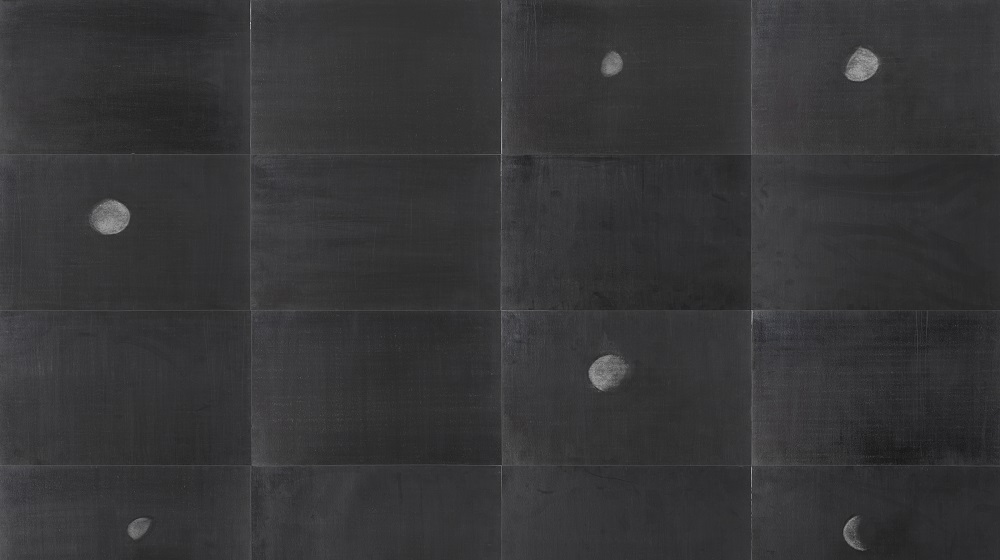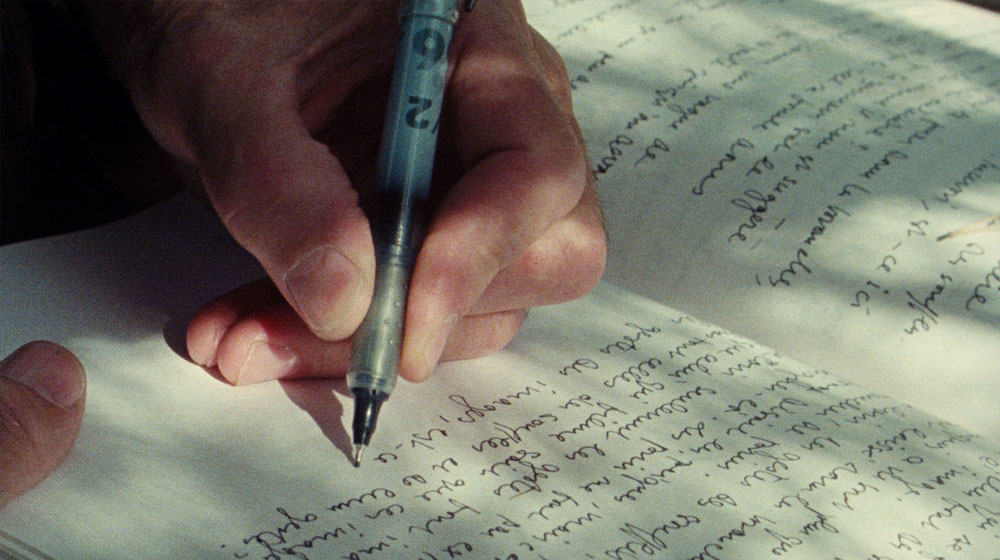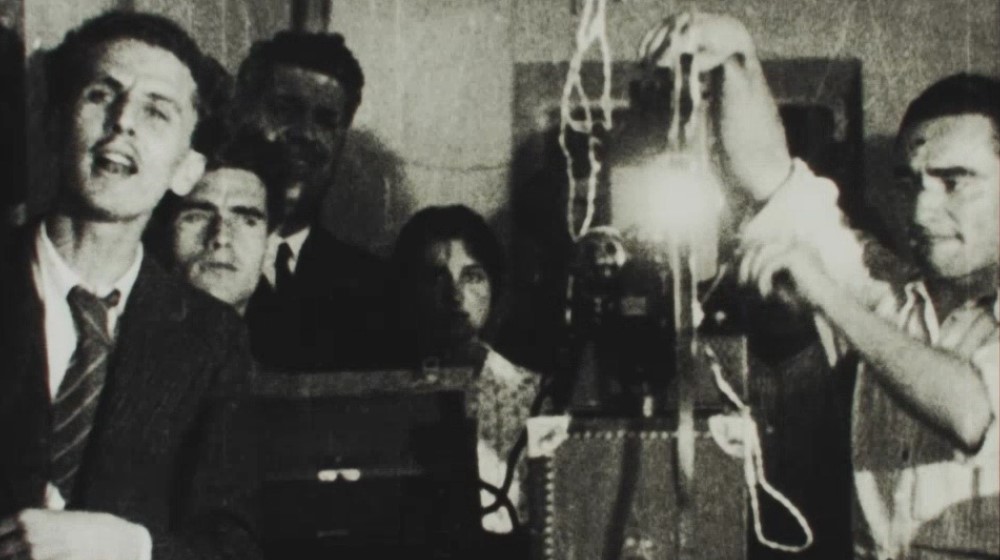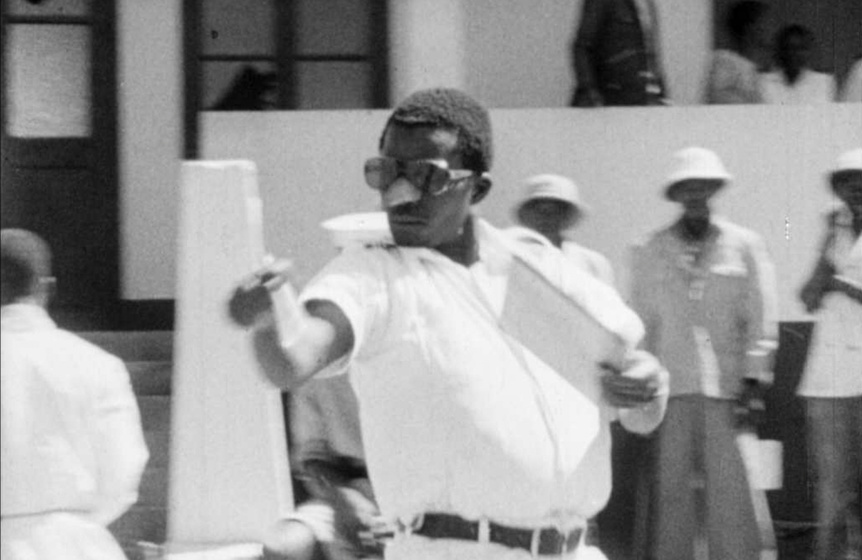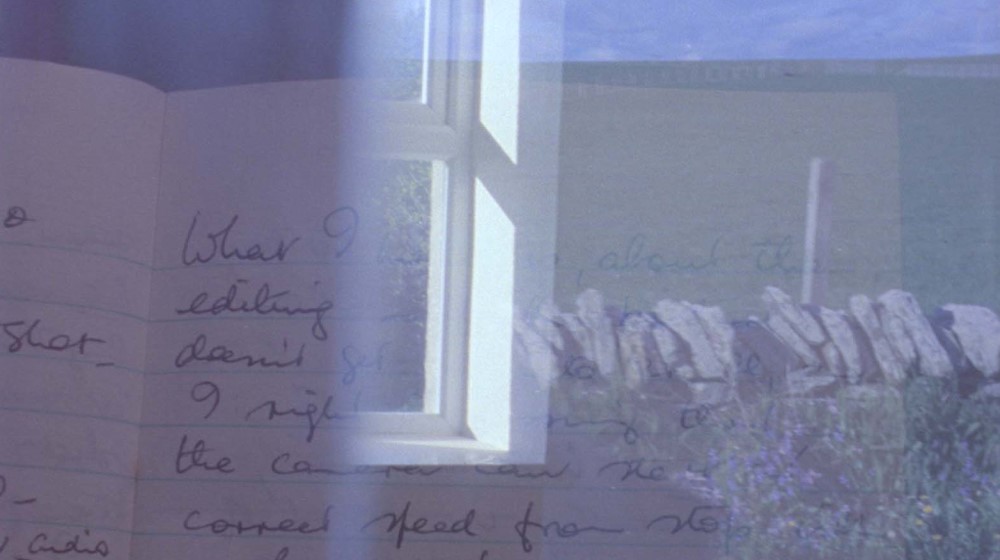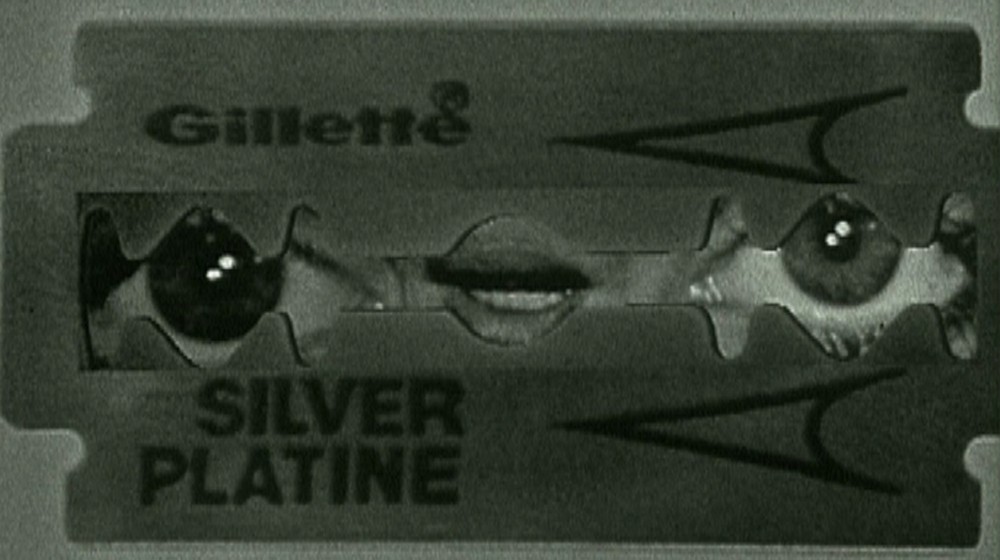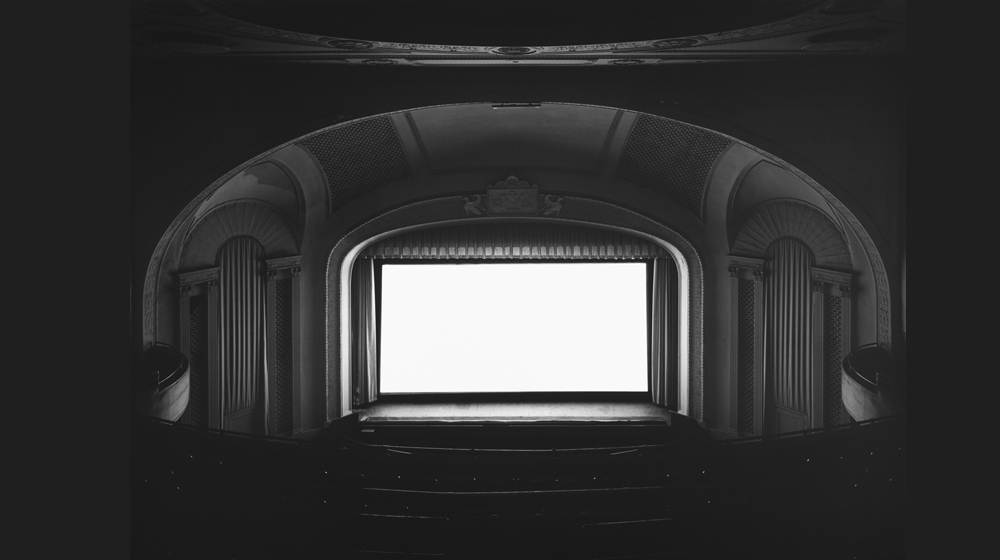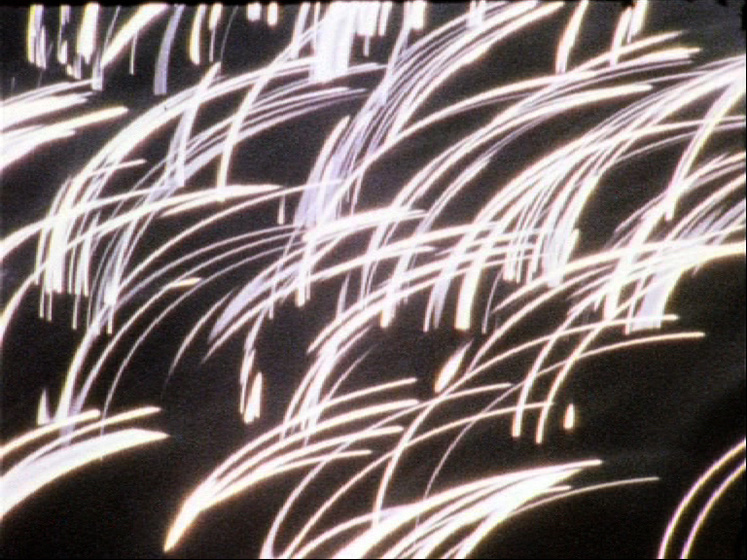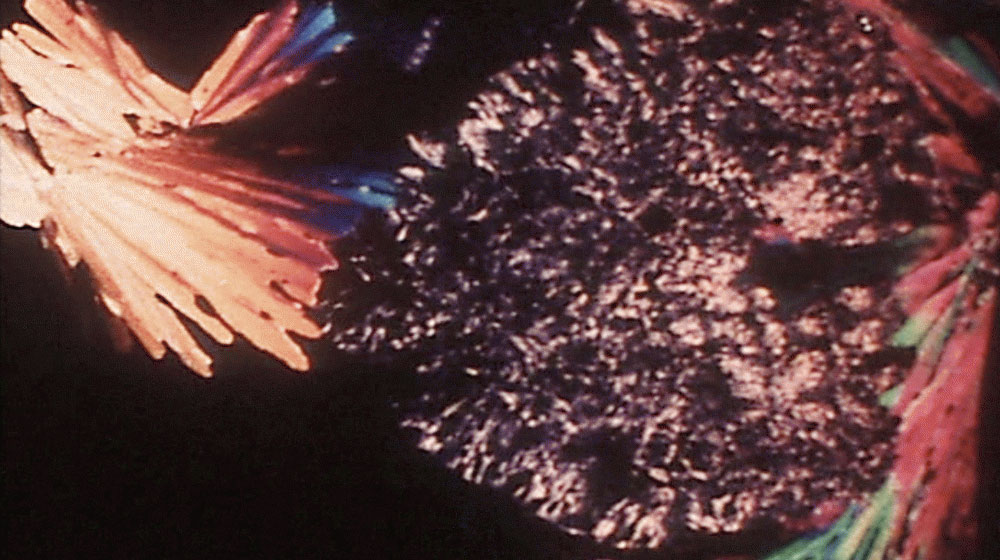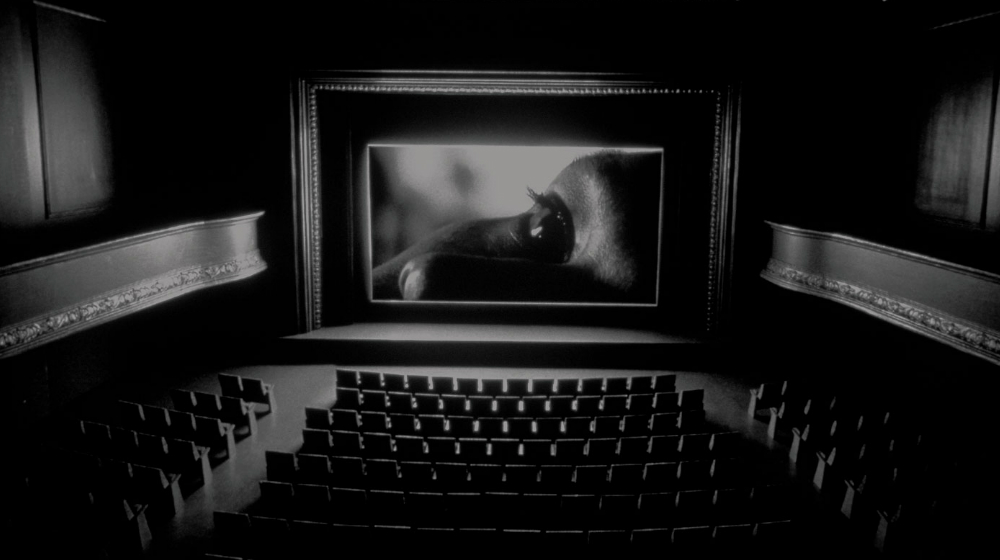A Lecture is one of the many talks given by Hollis Frampton in which he combined screenings with thoughts on the nature of cinema and its history.[1] The American filmmaker used to call these presentations medicine shows,[2] alluding not only to his interest in science and scientists[3] but also to a now-forgotten genre that was common in early film screenings, namely film lectures, films that were accompanied by scientific talks, aimed at both the general public and experts.[4] This talk, however, given using a projector, screen, recorded voice, red filter and pipe cleaner, was solely about the projection space itself: the "generic darkness", the "emerging beam of light", the "eternal white rectangle" and the projector.
This minimal exercise in cinema and praise for the machine and place of projection was first presented more than 50 years ago at Hunter College in New York, on 30 October 1968, featuring the voice, recorded on magnetic tape, of Michael Snow[5] and also a turned-on projector, into which Frampton inserted some objects and his hand.[6] In addition to making four films, the cineaste used these material elements to explain, in a kind of early manifesto, that "the art of making films consists in devising things [not necessarily ribbons of film] to put into our projector", a machine that "will modulate the emerging beam of light" and has the capacity to confine the "rectangle of white light" that "is eternal". "So and so many watts of energy spread over a few square yards of featureless white screen in the shape of a carefully standardised rectangle, three units high by four units wide. [...]. So it seems that a film is, first, a confined space at which [...] we, a great many people, are staring".[7]
The apparent simplicity of this piece, which reduces cinema to its core elements, nevertheless reveals deep and complex features of the cinematic device and establishes links with other works that also used a blank screen to display the projection space, a space designed not to be seen. Frampton cites Takehisa Kosugi's Film and Film #4 (1965) (in which the Japanese composer made a series of concentric rectangular cuts from the centre of a screen, illuminated by a beam from a projector, until the piece itself disappeared[8]) as an example of this type of film which, by not making use of printed celluloid, fits perfectly with the cinematic machine. However, we could also cite other works such as Nam June Paik's transparent film Zen for Film (1962-1964), L'espectador (1967) by Carles Santos, Tony Conrad's Yellow Movies (1972-1973), a set of white paintings of rectangular proportions and frames similar to the cinema screen, or even Hiroshi Sugimoto's series of photographs Theaters, works that also present the neutral space established over the years by cinema for projection.[9] Sugimoto, in an attempt to portray this, placed his camera in old cinemas in the United States, leaving the shutter open while films were being projected. As a result, the white screens recorded in his series of photographs radiate the light of all the images projected, in a way materialising what Frampton notes in A Lecture: "it is only a rectangle of white light, but it is all films, [...] perhaps its sheer presence has as much to tell us as any particular thing we might find inside it". [10]
"Now suppose that we project all film"[11] ["every film that has ever been made, for any purpose whatever", "instructional films, sing-alongs, endoscopic cinematography, and much, much more", a kind of infinite film that "contains an infinity of endless passages wherein no frame resembles any other in the slightest degree, and a further infinity of passages wherein successive frames are as nearly identical as intelligence can make them"].[12] Although Frampton realises that not all films can be seen at the same time in the same cinema, he continues with this exercise of phenomenological reduction, which he carries out in A Lecture and then suspends, interrupting the flow and categories related to the cinematographic sphere, to wonder: "What are they [all films] about, in their great numbers?"[13] A question which he answers to some extent in a later article, suggesting they are about "the machine called film",[14] although in this lecture he already points to the parts of that machine, describing its material characteristics: the film (a narrow, transparent strip composed of a series of fixed images that modulate the projector's beam of light), the projector (operating phantasmagorically by setting images in motion) and also the camera (a mechanism for printing on film which, at some point, was sensitive to light). "The sum of all films, all projectors and all cameras in the world constitutes [this] machine" [the Last Machine, as Frampton calls it] (...), an object akin to "the vaults of an endless film archive" incorporating "many millions of feet of raw stock". [15]
"Film, looking at itself as the total machine that is cinema, rephotographs and reprojects its own image, simply reiterates to unmodified indefinity its radiant rectangle".[16] The fact that, for Frampton, film cannot be reduced to the ribbon of film, camera or projector but is the sum of all these things taken together, enabled him to break with the classical distinction between film production and cinematographic projection and place the machine of cinema and its infinite reproducibility[17] at the centre, moving the author and their psychology to one side, thereby illustrating his conviction that "nothing in art is expendable as the artist himself".[18] Freed from the realm of personal expression, the filmmaker is therefore faced with an arduous task; namely to salvage the fundamental conditions and limits of their art. In fact, Frampton describes his work as that of a labourer, a tough, monotonous job in which he assembles small fragments of anonymous material to produce the ribbon of film. Consequently, this exercise of suspension (epoché) or reduction to which cinema is subjected in A Lecture is not ahistorical[19] but quite the opposite. However, this is something the author will develop in later writings.[20] For the moment, he invites us to contemplate our rectangle for a while longer and to invent ways of changing it.
Post Scriptum: Blackout[21]
Imagine a space, a scene, a simple, clear composition:
The figure of a prisoner who, his eyes shut, takes four steps forward and four steps back.
Three spotlights illuminate his cell as if it were daylight.
An immensity of watts spread over the few square metres of a standardised white screen.
Imagine their filaments tangling together and transforming into an ever-moving tide of colour.
Like in the cinema, when the film breaks.
The function is flawless. It's carried out by a precision piece of machinery that repeats it endlessly, with total accuracy. Its scope of action may be limited but it's like an animal, infallible.
Imagine insects of all kinds at the windows, dead birds, pheasants and pigeons, buzzing around.
They make the space spin and vibrate like light filaments.
Imagine a snowstorm inside a cell in the middle of August and thousands of small flames at the bars.
The traces of a frenzied whirlwind.
Imagine the prisoner's fear and exhaustion and his body about to disintegrate.
The closer we look, the more imprecise and slippery everything becomes. As if looking through a sheet of milky glass.
He calms himself by humming. He wanders around, taking cover as best he can but struggles to find his bearings with his tune.
He closes his eyes.
Flashes of light form perfect circles before his eyes: inside, a kind of arabesque in continuous movement, forwards and backwards, impairs his vision.
Something circular, ancient, omnipresent and a little absurd.
Imagine a screen that goes on and on with its characters trapped, without anyone seeing them. It was here before we came and it will still be here after we've gone.
Imagine a prison in that eternal space of light that is all film.
Based on texts by Nanni Balestrini, Hollis Frampton, Luigi Nono, Giles Deleuze, Edward Gordon Craig and Manoel de Oliveira.
Celeste Araújo
[1] The Invention Without a Future (1979) is the title of another talk given by the cineaste at an event entitled "Researches and Investigations into Film: Its Origins and the Avant-Garde" held at the Whitney Museum on 17 November 1979, in which he showed a selection of films printed on paper from the collection of the US Library of Congress.
[2] See Jenkins, Bruce. "Collecting His Thoughts: Remarks on the writing of Hollis Frampton" in On the Camera Arts and Consecutive Matters: The Writings of Hollis Frampton (2009). Massachusetts: MIT Press. p. 12.
[3] This interest is present not only in the lectures given by Frampton but also in many of his articles and films. We're referring, for instance, to the Scottish physicist James Clerk-Maxwell in his film Maxwell's Demon (1968), and to the German mathematician Max August Zorn and his lemma in Zorn's Lemma (1970).
[4] These film lectures were typical in the early days of film projection. They consisted of scientific films on topics such as X-rays, solar eclipses, travelogues or hygiene and were usually accompanied by explanatory talks.
[5] Michael Snow collaborated with Frampton on other films and also lent his voice to (nostalgia) (1971). See Snow, Michael. "On Hollis Frampton" in The Collected Writings of Michael Snow (1994). Wilfrid Laurier University Press, pp. 240-248.
[6] On the twentieth anniversary of Xcèntric, Frampton's legendary lecture was recreated in the auditorium of the CCCB. Valentina Alvarado Matos, in her role as an infallible interpreter who supports us, read the text of A Lecture translated into Spanish, with Carlos Vásquez Méndez operating the projector and the resulting objects.
[7] Frampton, Hollis. "A Lecture", in On the Camera Arts and Consecutive Matters: The Writings of Hollis Frampton, pp. 125-128.
[8] In addition to very clear references to the material conditions of the projection process, the alternating black and white actions in Kosugi's Film and Film #4 evoke positive and negative images, while the cuts in the screen suggest cinematic elements such as framing, zooming and editing.
[9] See Aráujo, Celeste. "Matèries per projectar un relat de la pantalla" in Pantalla Global (2012). Barcelona: Centre de Cultura Contemporània de Barcelona, pp. 86-95.
[10] Frampton, Hollis. "A Lecture", pp. 125, 130.
[11] Idem, p. 128.
[12] Frampton, Hollis. "For a Metahistory of Film: Commonplace Notes and Hypotheses", in On the Camera Arts and Consecutive Matters: The Writings of Hollis Frampton, pp. 86-95.
[13] Frampton, Hollis. "A Lecture", p. 128.
[14] Frampton, Hollis. "For a Metahistory of Film: Commonplace Notes and Hypotheses", p. 137.
[15] Idem, p. 137.
[16] Frampton, Hollis. "The Withering Away of the State of the Art" (1974), in On the Camera Arts and Consecutive Matters: The Writings of Hollis Frampton. p. 264.
[17] This echoes the idea of "technical reproducibility" and the consequent democratisation and politicisation of art noted by Walter Benjamin in "The Work of Art in the Age of its Technical Reproducibility" (1936), an essay alluded to by Frampton in a later lecture, The Invention Without a Future (1979). See On the Camera Arts and Consecutive Matters: The Writings of Hollis Frampton, pp. 171-182.
[18] Frampton, Hollis. "A Lecture", p. 17.
[19] In an interview with Adele Friedman in 1978, Frampton says that it would be impossible for him to develop any work or project without a historical vision, something he puts down to his Marxist training. See Frampton, Hollis. "Interview at the Video Data Bank" in On the Camera Arts and Consecutive Matters: The Writings of Hollis Frampton, p. 183.
[20] See Frampton, Hollis. "For a Metahistory of Film: Commonplace Notes and Hypotheses", pp. 131-139.
[21] Text written for the reworking of the collection of poems Blackout (1979) by Nanni Balestrini presented in La poesia fa male, the public programme of the [Virreina] Centre de la Imatge in relation to the exhibition Nanni Balestrini. La Violencia Ilustrada (March-May 2021). On the other hand, Blackout is also the name of a card with notes found in Hollis Frampton's archive deposited at the Anthology Film Archives. It is an undated and unrealised project in which the public is invited to imagine a film without using a projector. See Walley, Jonathan. "Identity Crisis: Experimental Film and Artistic Expansion" in October, Summer 2011, Vol. 137. pp. 23-50.

